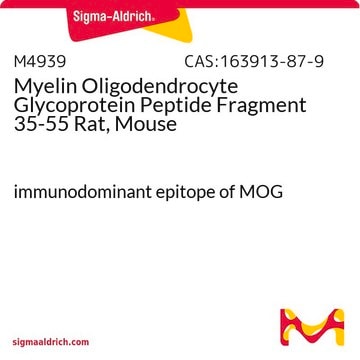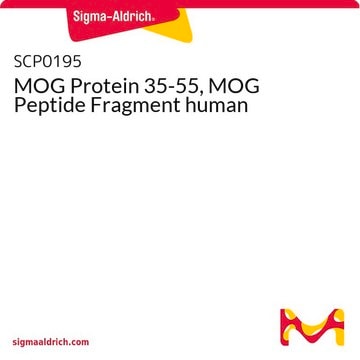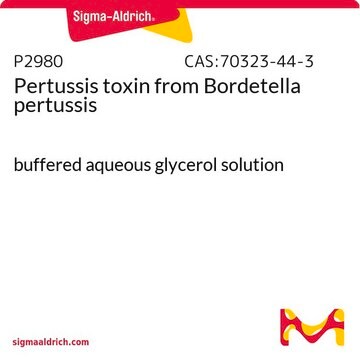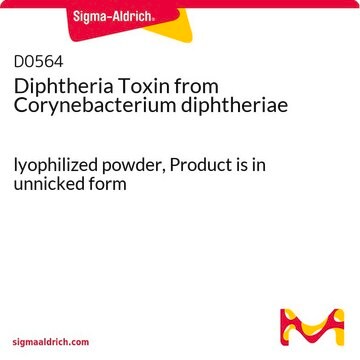516852
Pertussis Toxin, B Oligomer, Bordetella pertussis - Calbiochem
Sign Into View Organizational & Contract Pricing
All Photos(1)
About This Item
Recommended Products
form
lyophilized
impurities
≤1% holotoxin (by CHO cell assay)
solubility
aqueous buffer: soluble
sterile distilled water: soluble
General description
The pentameric cell-binding component that is responsible for binding of the holotoxin to eukaryotic cell surfaces, facilitating entry of the A protomer into receptive cells. Reported to elicit direct cellular responses by binding to several cell surface receptors with oligosaccharide side chains. Also elicits a variety of physiological responses, such as mitogenesis in human T cells, enhancement of aggregation of human platelets, elevation of cytosolic Ca2+ levels, and neutralization of antibody response in mice. Reported to deactivate CCR5 and inhibit the entry of R5 HIV-1 in activated T lymphocytes. Also blocks post-entry step of HIV-1 replication.
Biochem/physiol Actions
Cell surface receptors with oligosaccharide side chains
Reconstitution
Following reconstitution, refrigerate (4°C). Stock solutions, prepared from high ionic strength buffers, are stable for up to 3 months at 4°C.
Analysis Note
Four distinct bands by SDS-PAGE
Certificates of Analysis (COA)
Search for Certificates of Analysis (COA) by entering the products Lot/Batch Number. Lot and Batch Numbers can be found on a product’s label following the words ‘Lot’ or ‘Batch’.
Already Own This Product?
Find documentation for the products that you have recently purchased in the Document Library.
E L Hewlett et al.
Infection and immunity, 40(3), 1198-1203 (1983-06-01)
Exposing Chinese hamster ovary cells in culture to pertussis toxin resulted in a novel clustered growth pattern. The specificity of the response for pertussis toxin was shown by neutralization of the activity with specific anti-toxin antibody, heat lability (80 degrees
M Tamura et al.
Biochemistry, 21(22), 5516-5522 (1982-10-26)
The subunit structure of islet-activating protein (IAP), pertussis toxin, has been analyzed to study a possibility that this protein is one of the A-B toxins [Gill, D. M. (1978) in Bacterial Toxins and Cell Membranes (Jeljaszewicz, J., & Wadstrom, T.
M Alfano et al.
Journal of immunology (Baltimore, Md. : 1950), 166(3), 1863-1870 (2001-02-13)
We have recently shown that the binding subunit of pertussis toxin (PTX-B) inhibits the entry and replication of macrophage-tropic (R5) HIV-1 strains in activated primary T lymphocytes. Furthermore, PTX-B suppressed the replication of T cell-tropic (X4) viruses at a postentry
Y Sato et al.
Infection and immunity, 41(1), 313-320 (1983-07-01)
The role of the filamentous hemagglutinin (FHA) and the lymphocytosis-promoting factor hemagglutinin (LPF) in pertussis pathogenesis and immunity is the subject of active investigation. To be certain of their role as protective antigens, the hemagglutinins must be pure and free
W S Wong et al.
Canadian journal of physiology and pharmacology, 74(5), 559-564 (1996-05-01)
Pertussis toxin (PTX) is a heterohexameric protein, which is divided into subunits A and B. The A-subunit (protomer) possesses adenine diphosphate (ADP) ribosyltransferase activity, and the B-oligomer confers cell surface binding specificity on the toxin. By virtue of the ADP-ribosylation
Our team of scientists has experience in all areas of research including Life Science, Material Science, Chemical Synthesis, Chromatography, Analytical and many others.
Contact Technical Service





